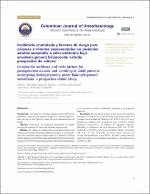Incidencia acumulada y factores de riesgo para náuseas y vómitos posoperatorios en pacientes adultos sometidos a colecistectomía bajo anestesia general balanceada: estudio prospectivo de cohorte

Related Resource(s)
https://journals.lww.com/rca/Fulltext/2020/03000/Cumulative_incidence_and_risks_factors_for.2.aspxDate
2020Author(s)
Shiraishi-Zapata, Carlos Javier
Arellano Adrianzén, Sheyla J.
Rodríguez Velarde, Giancarlo J.
Metadata
Show full item recordAlternate title
Cumulative incidence and risks factors for postoperative nausea and vomiting in adult patients undergoing cholecystectomy under balanced general anesthesia: a prospective cohort study
Abstract
Introducción: Las náuseas y vómitos posoperatorios (NVPO) son
problemas comunes que aparecen luego de la anestesia general,
para los que se han descrito varios factores independientes de
riesgo.
Objetivo: Determinar la incidencia acumulada de NVPO
durante las primeras 24 horas del periodo posoperatorio.
Métodos: Se realizó un estudio observacional prospectivo de
cohorte que incluyó a todos los adultos sometidos a colecistectomía
bajo anestesia general balanceada en el Hospital EsSalud
Talara desde octubre de 2014 hasta diciembre de 2016. Se evaluó la
presencia de NVPO durante las primeras 24 horas posoperatorias
y se ejecutaron análisis univariado, bivariado y de regresión
logística.
Resultados: Se incluyeron 244 pacientes, la mayoría con dos
factores de riesgo en la escala de Apfel, que presentaron una
incidencia acumulada de NVPO de 0.51 (IC 95% 0.45–0.57) en el
periodo de observación, a pesar de que el 85.25% recibió
profilaxis antiemética. El análisis de regresión logística
identificó la presencia de sexo femenino (OR 3.30, IC 95%
1.66–6.55, p=0.0007) y la historia de NVPO previos o cinetosis
(OR 2.67, IC 95% 1.25–5.68, p=0.011) como factores de
riesgo independientes para NVPO. Se halló independencia
entre la presencia de profilaxis antiemética y la presencia de
NVPO (p=0.92). Conclusiones: La alta incidencia acumulada de NVPO pudiera
ser ocasionada por el tipo de cirugía, uso de anestésicos volátiles y
falencias en la profilaxis farmacológica antiemética. Introduction: Postoperative nausea and vomiting (PONV) are
common issues arising after general anesthesia, for which several
independent risk factors have been described.
Objective: To determine the accumulated incidence of PONV
during the first 24hours of the postoperative period.
Methods: A cohort observational, prospective study was
conducted that included all the adults undergoing cholecystectomy
under balanced general anesthesia at the EsSalud Talara
Hospital from October 2014 until December 2016. The presence of
PONV during the first 24hours after surgery was assessed, and
univariate, bivariate, and logistic regression analyses were
conducted.
Results: 244 patients were included, most of them with two
risk factors in the Apfel scale, that represented an accumulated
incidence of PONV of 0.51 (95% CI 0.45–0.57) during the
observation period, notwithstanding the fact that 85.25% received
antiemetic prophylaxis. The logistic regression analysis identified
that being a female (OR 3.30, 95% CI 1.66–6.55, p=0.0007) and
previous PONV or motion sickness (OR 2.67, 95% CI 1.25–5.68, p=
0.011) were independent risk factors for PONV. The administration
of antiemetic prophylaxis and the presence of PONV (p=0.92)
were found to be independent.
Conclusions: The high cumulative incidence of PONV could
be the result of the type of surgery, the use of volatile
anesthetic agents, and errors in the antiemetic pharmacological
prophylaxis.
Collections
- Artículos científicos [890]





